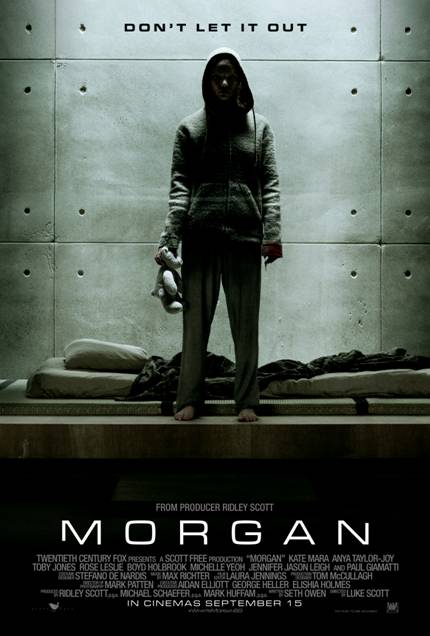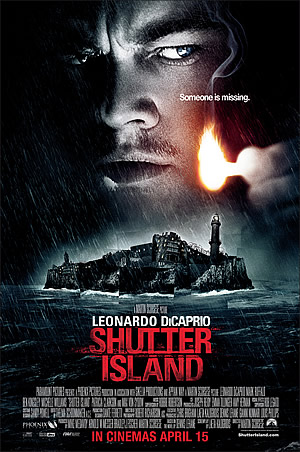A CURE FOR WELLNESS (2017)
Genre: Mystery/Thriller
Director: Gore Verbinski
Cast: Dane DeHaan, Jason Isaacs, Mia Goth, Adrian Schiller, Celia Imrie, Lisa Banes, Carl Lumbly, Magnus Krepper
Runtime: 2 hrs 28 mins
Rating: M18 (Sexual Scenes & Nudity)
Released By: 20th Century Fox
Official Website: https://www.facebook.com/CureForWellness/
Opening Day: 16 February 2017
Synopsis: An ambitious young executive is sent to retrieve his company's CEO from an idyllic but mysterious "wellness center" at a remote location in the Swiss Alps. He soon suspects that the spa's miraculous treatments are not what they seem. When he begins to unravel its terrifying secrets, his sanity is tested, as he finds himself diagnosed with the same curious illness that keeps all the guests here longing for the cure. From Gore Verbinski, the visionary director of THE RING, comes the new psychological thriller, A CURE FOR WELLNESS.
Movie Review:
With a repertoire consisting of The Ring (2002), the first three films of the box-office Pirates of the Caribbean series (2003-2007), as well as his last film, action western movie The Lone Ranger (2013), director Gore Verbinski’s movies seems to have become synonymous with hefty budgets, high visual impact and a healthy dose of entertainment (though with varying degrees of success). And A Cure for Wellness manages to tick off most of these boxes, channelling its generous budget into visual artistry and an overall good time to be had by audiences.
The lead character is finance executive Lockhart, played by Dane DeHaan, who could pass off as the younger corporate cousin of Leonardo DiCarprio in The Wolf of Wall Street. He jets off to Europe on a mission to fetch his CEO Pembroke (played by Harry Groener) from the wellness retreat back to Manhattan in order to sign some crucial business documents. Unfortunately, Lockhart gets into an accident before he succeeds and has to stay on in the same sanatorium while his broken leg recovers. Aptly cast with his pallid face and sunken eyes, DeHaan’s Lockhart looks like he is in need of some rejuvenating hydrotherapy himself, and that is exactly what he gets at the sanatorium on the advice of Dr. Heinreich Volmer (played by Jason Isaacs), head of the institute that administers the spa wellness programmes.
Along the way, Lockhart strikes an unlikely friendship with the waifish Hannah (played by Mia Goth – that last name though!), a long-time patient at the sanatorium who has to take special “vitamins” from a vial. The rest of the clientele seem like well-heeled, elderly types perpetually clothed in bathing robes whose only agenda is to relax and partake in hydrotherapy exercises scheduled for them. As other seedy details emerge, including that of the sanatorium’s fascinating history as a former castle, Lockhart’s quest shifts from retrieving Pembroke to subverting the nefarious operations behind the wellness centre; one’s impression of him as unlikeable mercenary transitions to that of unlikely hero by the end of the film.
For those acquainted with Bram Stoker’s Dracula, the film feels almost like an updated re-telling of the gothic classic, with a science fiction twist thrown in for good measure. A guy visits a remote castle on business and gets more than what he bargains for? Check. In place of the titular Count, here there is a backstory of a baron who used to inhabit the sanatorium in its old castle days, committing unspeakable atrocities in his pursuit of keeping his royal lineage pure. And as with Dracula’s drawing of human blood for sustenance, the wellspring of human longevity in this film is tapped from sinister sources that are revealed towards the end of the film.
It’s a gorgeous flick and much of the credit goes to the excellent cinematography (by Bojan Bazelli, who also worked in the same capacity on The Ring with Verbinski) and opulent production design (by Eve Stewart). The ominous tone of the film is established right from the outset, as the camera pans across cold, monolithic Manhattan skyscrapers before the story shifts to the Swiss Alps. Ensconced in the middle of the mountains, the panoramas from the wellness centre are breath-taking, yet its isolation away from the rest of modern civilisation becomes uncomfortably palpable. The set design of the wellness centre doesn’t fail to impress either, recreated with its dank interiors, snaking corridors and clinical chambers.
Indeed, every shot feels painstakingly framed and the choice of colour palette of every scene appears to be measured and deliberate. Even the turquoise tiles of Lockhart’s room at the sanatorium appear to match the shade of green in his piercing eyes. There is plenty of interplay between light and darkness, reflections and refractions, enough to make even the most jaded of cinemagoers to sit up and appreciate its visceral aesthetic. Benjamin Wallfisch’s ominous score is the icing on the cake, perpetuating the requisite sense of dread throughout the entire film.
Despite the above, the film does suffer from a few major problems, most evident of which are the pacing and length of the film. With a staggering runtime of 146 minutes, it could absolutely do with niftier editing – surely at least half an hour or more of the film should have ended up on the cutting room floor. Crucial plot information is revealed at a frustratingly slow pace, with several scenes that seem to contribute little in propelling the storyline forward. It definitely feels as though the obsession with getting the visuals just right has come at the expense of tighter storytelling.
For example, bloodthirsty eels, – one of the major motifs of the film (perhaps doubling as some sort of symbol of fertility?) – while beautifully rendered, spring up so often as a device to elicit the jitters that it becomes somewhat tiresome. Another example: there are at least three separate scenes (functioning purely to manufacture a sense of unease but otherwise mostly superfluous) showing how the flush lever of the toilet bowl in Lockhart’s room rattles by itself, before he decides to uncover its cause. And when he finally does, there is no surprise to be had as audiences are already primed to guess why. For those expecting to be amply rewarded with a shocking climax after waiting out the length of the film, the pay-off is scant – too much is foreshadowed and it doesn’t take a genius to deduce the eventual twists in the story.
Ultimately, the subtext of the film seems to be an indictment on the malaise of modern life and how its cure could be as simple as exercising the choice to recognise its afflictions and remove oneself from its trappings and stresses. Although the film only flirts with rather than engages this premise full-on, one gets the feeling that the filmmakers are content not to take things further in that direction anyway. A Cure for Wellness is unlikely to be remembered as the latest feather in Verbinski’s cap, but whatever it is that the film falls short of in storytelling, this handsome film manages to makes up for it with its sumptuous visuals and richly macabre atmosphere.
Movie Rating:



(This gothic film is a feast for the senses and manages to keep things sufficiently entertaining, although the length and protracted pacing of the film will prove challenging for some)
Review by Tan Yong Chia Gabriel
You might also like:




